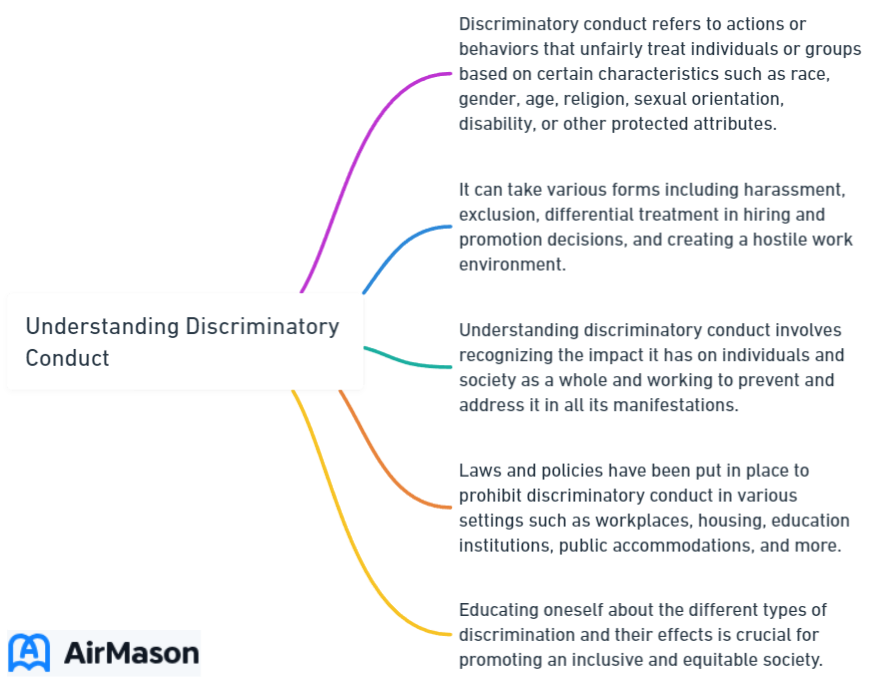
In today’s diverse society, understanding and addressing discriminatory conduct at the workplace is crucial. By acknowledging the different types of discrimination, the legal framework that governs them, and the responsibilities of both employers and employees, we can take active steps towards creating a more inclusive and respectful work environment. So, let’s dive in and explore the world of discriminatory conduct in 2024, with the hope of empowering ourselves to make a real difference.
Key Takeaways
- Recognizing discriminatory conduct is essential to create an inclusive workplace.
- Employers must take proactive steps against unwelcome or offensive behavior and provide reasonable accommodations for employees with disabilities in order to comply with the ADA.
- Employees have the right to report any discriminatory conduct without fear of retaliation, filing a complaint with EEOC or internal HR department if necessary.
Types of Discriminatory Conduct
Discrimination can come in various forms, including:
- Sex discrimination
- Racial discrimination
- Ethnic discrimination
- Discrimination based on sexual orientation
- Discrimination based on gender identity
Recognizing such conduct is the first step towards addressing and combating it effectively.
Understanding the nuances of these different types of discrimination will help us foster a more inclusive and equitable workplace for everyone.

Sex Discrimination
Sex discrimination refers to unequal treatment or impact based on one’s sex or gender. This can take several forms, such as sexual harassment, which is considered a type of sex discrimination. In the workplace, sexual harassment may manifest as inappropriate comments, innuendos, or even unwelcome physical contact. These actions can create a hostile environment, making it difficult for employees to perform their jobs effectively.
Title VII of the Civil Rights Act of 1964 aims to prevent sex discrimination by prohibiting employers from engaging in such behavior. Awareness and adherence to the legal standards set by Title VII can help employers maintain an environment free from sex discrimination and sexual harassment, promoting a more equal workplace for all.
Racial and Ethnic Discrimination
Racial and ethnic discrimination involves differential treatment based on one’s race, color, or national origin. An example of this could involve the selection of a job candidate, which might be interpreted as discriminatory if it shows a pattern of favoring certain age groups or races, especially among federal employees. In some cases, prohibiting employees from speaking a language other than English could also be considered discriminatory, as it may be perceived as unequal treatment based on ethnicity.
Title VII of the Civil Rights Act of 1964 is a federal law that prohibits employment discrimination based on:
- Race
- Color
- Religion
- Sex
- National origin
Understanding the legal framework and taking proactive steps against racial and ethnic discrimination empowers employers to cultivate a more inclusive and diverse work environment.
Sexual Orientation and Gender Identity
Discrimination based on sexual orientation and gender identity involves unequal treatment due to an individual’s sexual orientation or gender identity. This type of discrimination can manifest in various ways, such as:
- Employment discrimination
- Housing discrimination
- Harassment
- Denial of services
In 2020, the Supreme Court ruled that Title VII of the Civil Rights Act, as well as the Ontario Human Rights Code, extends to discrimination based on sexual orientation, gender identity, marital status, and parental status. This landmark decision offers legal protections for LGBTQ+ individuals and others in employment.
Employers must implement inclusive policies and foster a supportive work environment to minimize the implications of such discrimination, which can create a hostile work environment and impact career advancement, wages, and even termination.
Harassment Policy at Workplace
The harassment policy at our workplace is designed to create a safe and inclusive environment for all employees. It outlines the company’s commitment to preventing and addressing any form of harassment, be it based on race, gender, religion, or any other protected characteristic. This policy applies to all employees, contractors, clients, and visitors within the premises, and extends to all work-related activities and interactions, both within and outside the office. The core objective of this policy is to foster a culture of respect, understanding, and open communication, ensuring that every individual feels valued and supported. In the event of any harassment complaint, a thorough investigation will be conducted, and appropriate actions will be taken, which may include disciplinary measures in accordance with company guidelines and local laws. By upholding this harassment policy at the workplace, we aim to promote a professional atmosphere that encourages growth, creativity, and mutual respect among all members of our team.
Legal Framework

To combat discriminatory conduct, various laws have been enacted, including Title VII of the Civil Rights Act of 1964, the Americans with Disabilities Act (ADA), and the Age Discrimination in Employment Act (ADEA). These laws provide a framework to protect individuals from discrimination based on race, color, religion, sex, national origin, disability, and age.
Understanding and adhering to these legal frameworks can help employers provide a fair and inclusive work environment for all employees.
Title VII of the Civil Rights Act of 1964
Title VII of the Civil Rights Act of 1964 prohibits discrimination on the basis of:
- Race
- Color
- Religion
- Sex
- National origin
This includes not only employment decisions but also limiting, segregating, or classifying employees in a way that could deny individuals of employment opportunities based on protected characteristics.
Religious discrimination is also addressed under Title VII, with the United States Supreme Court determining that religion is not limited to any specific denomination. Protection is extended to those who do not subscribe to any religion, and a sincere belief equivalent to the belief in a higher power is sufficient for a reasonable person.
Understanding and adhering to the legal standards set by Title VII equips employers to create a discrimination and harassment free environment, fostering a more equal workplace for all.
Americans with Disabilities Act (ADA)
The Americans with Disabilities Act (ADA) is a federal law that prohibits discrimination against individuals with disabilities in various areas, including the workplace. Employers are required to provide reasonable accommodations to employees with disabilities, enabling them to perform their job duties.
Examples of reasonable accommodations for employees with disabilities may include:
- Job restructuring
- Modified work schedules
- Acquisition or modification of equipment and devices
- Improving accessibility in the work area
- Providing interpreters or personal assistance.
Understanding the legal framework and taking proactive steps to prevent and address discrimination based on disability and family medical history allows employers to cultivate a more inclusive and diverse work environment.
Age Discrimination in Employment Act (ADEA)
The Age Discrimination in Employment Act (ADEA) provides protection from age-based discrimination for employees aged 40 and above. The key elements of the ADEA include prohibiting age discrimination, safeguarding against harassment, and providing exceptions for specific age distinctions.
The Equal Employment Opportunity Commission (EEOC) is responsible for enforcing the ADEA. Employers must adhere to the legal framework and address age discrimination to ensure a more inclusive and diverse work environment for employees of all ages.
Recognizing Discriminatory Conduct
Discriminatory conduct can manifest in various forms, such as unwelcome, offensive, or discriminatory or harassing behavior. Recognizing these behaviors is crucial for addressing and remedying the situation.
Vigilance and understanding the different types of discriminatory conduct can help employees and employers work together to create a more inclusive and respectful work environment.
Unwelcome Conduct
Unwelcome conduct is any behavior that is not desired or requested by the recipient, often targeting a person’s protected status. Employers have a responsibility to address unwelcome conduct in the workplace, including taking immediate steps to prevent unlawful harassment and retaliation.
Examples of unwelcome conduct may include:
- Making derogatory remarks
- Displaying offensive visuals
- Initiating unwanted physical conduct
- Making unwanted sexual advances
Employers must ensure a non-hostile work environment and provide appropriate accommodations for employees who experience unwelcome conduct.
Offensive Conduct
Offensive conduct encompasses jokes, slurs, or comments that disparage or denigrate someone based on their protected status, including racial or ethnic slurs. Examples of potentially offensive conduct may include:
- Offensive jokes, slurs, epithets or name calling.
- Physical assaults or threats, intimidation, ridicule or mockery, insults or put-downs.
- Offensive objects or pictures, and interference with work performance.
Offensive conduct in the workplace can lead to a hostile and uncomfortable atmosphere for employees, resulting in decreased morale and productivity. It is important for employers to be aware of and address offensive conduct to create a more inclusive and respectful work environment.
Harassing Behavior
Harassing behavior in the workplace can include:
- Offensive jokes
- Slurs
- Epithets
- Name-calling
- Inappropriate or rude comments
- Personal humiliation
- Overly critical remarks
- Ostracizing behaviors
- Verbal abuse
- Vulgar or derogatory language
- Display of offensive materials
- Mimicry
- Lewd or offensive gestures
- Demotion
- Termination
- Failure to promote
- Unwarranted discipline
- Making the offensive conduct a condition of employment.
Harassing behavior can lead to a hostile work environment, impacting employees’ mental and emotional well-being. Employers must take appropriate measures to address harassment and foster a culture of respect and inclusivity in the workplace.
Sexual Harassment Policy
The sexual harassment policy of our organization stands as a fundamental pillar in ensuring a safe and respectful work environment for all employees. This comprehensive framework outlines our commitment to preventing, addressing, and rectifying instances of sexual harassment within the workplace. It serves as a clear statement of our zero-tolerance approach towards any form of unwelcome conduct of a sexual nature. The sexual harassment policy delineates the various forms of inappropriate behavior, ranging from explicit advances to derogatory comments, and provides a step-by-step protocol for reporting and investigating such incidents. Furthermore, it emphasizes the protection and support offered to victims, ensuring that they can come forward without fear of retaliation, and that their concerns will be taken seriously and handled promptly and confidentially. Regular training and awareness programs are integral components of our sexual harassment policy, aimed at fostering a culture of respect and inclusivity, thereby upholding our commitment to a harassment-free workplace.
Employer Responsibilities

Employers have a responsibility to:
- Maintain a non-hostile work environment
- Provide reasonable accommodation for employees with disabilities
- Implement preventive and corrective measures to address discriminatory conduct.
Taking these steps can help employers create a more inclusive and respectful work environment, promoting employee well-being and productivity.
Maintaining a Non-Hostile Work Environment
A non-hostile work environment is one that is free of discriminatory harassment. Employers must take immediate steps to prevent harassment and retaliation and report any incidents of harassing conduct.
To ensure a non-hostile work environment, employers can:
- Provide regular training on harassment prevention
- Conduct thorough investigations into complaints
- Foster a culture of respect and inclusivity
- Address issues of poor management.
Reasonable Accommodation
Employers are required to provide reasonable accommodation for employees with disabilities under the Americans with Disabilities Act (ADA). Reasonable accommodations may include:
- Job restructuring
- Modified work schedules
- Acquisition or modification of equipment and devices
- Improving accessibility in the work area
- Providing interpreters or personal assistance
Providing reasonable accommodations not only ensures compliance with the ADA but also promotes an inclusive work environment where employees with disabilities can contribute to their fullest potential.
Preventive and Corrective Measures
Harassment in the workplace should be eliminated. The most effective way to do this is through prevention. Employers can implement preventive measures, such as:
- Providing training to employees on the company’s anti-discrimination policies
- Implementing a complaint process
- Conducting regular reviews of the workplace environment
For discrimination that has already occurred, corrective measures may include providing remedies to the victim, such as back pay, reinstatement, or other forms of compensation, and taking disciplinary action against the perpetrator. By taking proactive steps to prevent and address discriminatory conduct, employers can create a more inclusive and respectful work environment, utilizing preventive or corrective opportunities.
Employee Rights and Reporting Procedures

Employees have the right to engage in protected activity, such as reporting discrimination or participating in investigations, without fear of retaliation. They can file complaints with relevant agencies, such as the EEOC or internal human resources departments, to report discriminatory conduct.
Understanding their rights and reporting procedures empowers employees to contribute to a more inclusive and equitable workplace.
Protected Activity
Protected activity encompasses any action that is legally safeguarded, including reporting discrimination or participating in investigations. Employees engaging in protected activity are entitled to several protections, such as the right to access relevant investigation records and the right to privacy during the investigation.
Employees must remember that engaging in protected activity could lead to penalties if they do not adhere to the proper procedures and guidelines. Understanding their rights and engaging in protected activity responsibly contributes to creating a more inclusive and respectful work environment.
Filing Complaints
Employees can file a discrimination complaint with the EEOC by mail or in person at the nearest EEOC office. It is important to bear in mind that there may be an expiration date for filing a complaint, usually 180 or 300 days depending on the situation.
To file a discrimination complaint with an internal human resources department, it is recommended to submit a formal email or letter complaint, adhering to any procedures indicated in the company’s policy or employee handbook. Understanding their rights and reporting procedures empowers employees to contribute to a more inclusive and equitable workplace.
Retaliation
Retaliation refers to the act of punishing or taking adverse actions against job applicants or employees who exercise their rights to be free from discrimination or harassment in the workplace. Retaliatory actions may include:
- termination
- demotion
- suspension
- transfer
- reduction in pay or hours
- other forms of harassment
Numerous laws exist to protect employees from retaliatory actions, such as:
- The EEO laws
- The Employee Polygraph Protection Act
- The Fair Labor Standards Act (FLSA)
- Federal and state laws that safeguard employees when exercising certain rights.
Understanding their rights and reporting procedures empowers employees to contribute to a more inclusive and equitable workplace.
Anti Harassment Policy
Our organization is committed to providing a safe and inclusive environment for all members, employees, and stakeholders. This commitment is reflected in our comprehensive anti harassment policy which outlines our zero-tolerance stance towards any form of harassment. We firmly believe that everyone deserves to work, learn, and interact in an atmosphere free from any form of discrimination, intimidation, or offensive behavior. This policy encompasses not only overt acts of harassment but also addresses subtle forms of misconduct that may create an uncomfortable or hostile environment. We encourage open communication and actively seek to address any concerns promptly and confidentially. By upholding this anti harassment policy, we aim to foster a culture of respect, understanding, and mutual support within our community.
Summary
In conclusion, understanding and addressing discriminatory conduct is crucial for creating an inclusive and respectful work environment. By recognizing different types of discrimination, adhering to the legal framework, and fulfilling employer and employee responsibilities, we can take active steps towards fostering a more equitable workplace. Together, we can promote a culture of respect, inclusivity, and understanding in the workplace, paving the way for a brighter, more diverse future.
Frequently Asked Questions
What are some discriminatory actions?
Discriminatory actions include harassment, inappropriate jokes, insults, name-calling and displays directed at people based on their race, colour, sex, gender or sexual orientation.
What are the four types of discriminatory practices?
Discrimination is a reality that many people face, and the Equality Act of 2020 defines four types of discrimination: direct discrimination, indirect discrimination, harassment, and victimisation.
What is discriminatory behavior in the workplace?
Discrimination in the workplace refers to unfair treatment of individuals or groups based on their race, color, national origin, religion, sex, age, marital and parental status, disability, sexual orientation, gender identity, or genetic information. It manifests through hiring and firing practices, as well as workplace behavior.
What is an example of discriminatory act?
An example of a discriminatory act is when someone is treated differently or worse because of their sex, such as a nightclub offering free entry to women but charging men to get in. It can also be discrimination by association, like a café owner refusing service to someone because they associate with people who have a mental health problem. Additionally, denying access or services due to disability, such as cerebral palsy, and paying a colleague of the opposite sex less for the same work are other examples of discrimination.
What are the responsibilities of employers in preventing and addressing discriminatory conduct?
Employers have a duty to create an inclusive work environment, provide reasonable accommodation for employees with disabilities, and take proactive steps to prevent and address discriminatory conduct.